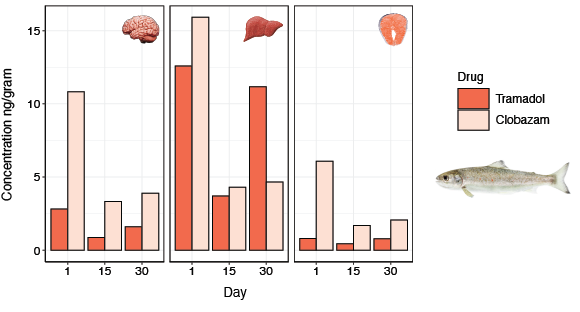Work package 1: What are the impacts of pharmaceuticals on individual behaviour and behavioural variability?
Most behavioural ecotoxicology studies focus on the mean behavioural response of the contaminated population, ignoring the variance that often exists among individuals. However, this variation is ecologically and evolutionarily important because (1) it’s what natural selection acts upon, and (2) it provides an indication of the adaptive potential of populations to environmental change. Many pharmaceuticals aimed at treating anxeity and stress do so my inhibiting behavioural expression (i.e. their goal is to make patients behave in a certain way). Similarly, these drugs could homogenise behaviour in non-target species, eroding away ecologically important behavioural variance, and, thus, impairing the ability of wildlife populations to respond to other environmental perturbations. The objective of work package 1 is to determine how exposure to pharmaceutical pollutants, both in isolation and in mixtures, affect fish behaviour and behavioural variability.
In this experiment, I will expose fish in the laboratory to one of four pharmaceutical treatments: freshwater control (0 ng/L), clobazam (500 ng/L), tramadol (500 ng/L) or a mixture of clobazam and tramadol (500 ng/L each). Clobazam and tramadol were selected for this experiment because they represent seperate major pharmaceutical classes with different modes-of-action (i.e. a benzodiazepine and an opoid painkiller, respectively). Both drugs are also frequently detected in surface waters and are of particularly high concern because they are known to have dangerous drug interactions in humans. This means that animals are being exposed to mixtures of medicines that would never be co-prescribed to human patients due to known adverse interactions!
Following the exposure treatment, fish will be measured for a suite of behavioural traits that are fundamentally important for survival, including activity, foraging behaviour, social behaviour and risk-taking behaviour. I will measure these behavioural traits in each fish three times (each test will be at least three days apart). This repeated testing approach will allow me to estimate consistent among-individual variability in these behaviours. All video trials will be video recorded and analysed using neural network maching learning (i.e. Mask R-CNN) for automated behavioural tracking in collaboration with Dr Alex Jordan at the Max Planck Institute of Animal Behaviour (MPI) in Konstanz, Germany. This approach will allow me to characterise generalisble and reproducible behaviours in fish, that I can then extrapolate and compare to behaviours seen in more natural conditions (see work packages 3 and 4)
Assays that I will use to quantify behaviour and behavioural variability in roach after treatment exposure. Each subject will undergo each assay three times (with at least a 3 day break between trials) to get an estimate of individual consistency and among-individual behavioural variation between treatment groups.
Preliminary data showing the bioaccumulation (ng/g) of tramadol and clobazam in the brain, liver and muscle tissue of two year-old salmon smolt over a 30 day period. To put these results into perspective, concentrations less than 1ng/g have been shown to compromise ecologically important behaviours in fish.

